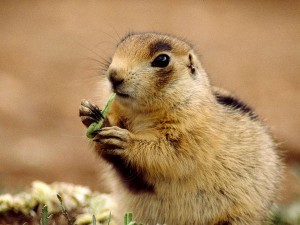Why everything matters; even the prairie dog!
[quote]“There is an old Navajo warning that if you kill off the prairie dogs there will be no one to cry for rain … In fact, the burrowing animals, like prairie dogs, open breathing tubes in the Earth. The underground aquifers act like the diaphragm in human bodies; the moon as it passes raises and lowers the underground water table and the Earth breathes through the many fissures and tubes opened by the burrowing creatures. The exhalation of moisture-ladened air, filled with negative ions, helps create rain.” Stephen Harrod Buhner in Sacred Plant Medicine[/quote] We are taught that we are all related, but how often do we acknowledge the contributions of the lowliest of animals, such as the prairie dog.
We are taught that we are all related, but how often do we acknowledge the contributions of the lowliest of animals, such as the prairie dog.
A member of the ground squirrel family, the best known of the five prairie-dog species is the black-tailed and they live in larger communities called towns which may contain hundreds of prairie dogs.
Prairie Dog communities are sophisticated
The largest recorded prairie dog town was found in Texas in 1900. It covered 25,000 square miles and was home to up to 400 million prairie dogs.
In the 20th Century, 98% of all prairie dogs were exterminated. They now live in only 5% of their historic habitat.
Their burrows have these remarkable features:
- Their burrows may extend for ninety feet with several side streets on either side of the main tunnel.
- Burrow construction creates circulation by sucking stale air out at one end while fresh air is drawn in by a lower entrance.
- The burrows are highly organized with front and back doors, segregated areas for nurseries, sleeping quarters, storage and toilets!
- There is frequently a reinforced dyke to protect against flooding and sudden rains.
- They also have listening posts near exits so the prairie dogs can keep tabs on predators.
Sociability
- Their burrows may be shared by snakes, burrowing owls and even rare black-footed ferrets, which hunt prairie dogs in their own homes.
- A family group consists of a male, a few females and their young.
- They work together to share food, chase off predators and groom one another.
- Family members will greet one another with a kiss or nuzzle.
- The young are as playful as puppies and kittens.
- Seeming to know how much food and land is available, they practice their own birth control and do not breed excessively.
- They forage outside of their dens during the day to feed on grasses, roots and seeds.
- All species hibernate during the winter and burn the stores of fat they have built up during the plentiful season.
Communication skills
Northern Arizona University biology professor and prairie dog linguist Con Slobodchikoff says prairie dogs are “showing the most sophisticated communication system that anyone has shown in animals.”
- Prairie dogs communicate with loud cries to warn of the approach of a predator such as a badger or coyote.
- A second “all clear” call announces that the danger has passed.
- They have an advanced communication system with over 50 different “words” for raptors, coyotes, humans, hawks, badgers, ferrets, snakes and even humans carrying guns.
- Their only defense is raising the alarm and disappearing quickly. They can run up to 35 miles an hour.
Their Contributions
Their major habitat was the Great Plains, much of which has been converted to farm or pastureland. Prairie dogs are not welcome there because their burrowing allegedly wreaks havoc on the farm and pastureland so they are often killed as pests.
- However, a growing number of experts agree that prairie dogs are beneficial because they increase the protein content and digestibility of rangeland grasses.
- They enrich and aerate the soil by digging burrows and adding fertilizer [their own feces and urine] — so much so that they have been called “fertilizing machines.”
- They also contribute to rainfall in dry areas as noted in the above quote from Sacred Plant Medicine.
- At least nine species of wildlife depend on prairie dogs, another 20 species use the colonies as their own homes or refuge from predators.
- Another 117 species benefit from prairie dog colonies.
Prairie dogs are a “keystone species” and have been termed by biologists as “perhaps the most important mammal on earth.”
Spiritual gifts
According to author Ted Andrews in Animal Speak, those who have prairie dog as their animal teacher will do better in communities than in going it alone. Get involved in community; there is power in numbers.
[quote]“Treat the earth and all that dwell thereon with respect.” First of the Indian Commandments[/quote]
Molly Larkin is the co-author of the international best-seller “The Wind Is My Mother; The Life and Teachings of a Native American Shaman” and other books on health. She is passionate about helping people live life to their fullest potential through her classes, healing practice and blog at www.MollyLarkin.com

